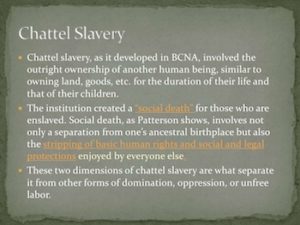
*On this date, we affirm the institution of Chattel Slavery in the United States of America. Spain instituted this episode in Puerto Rico and Florida circa 1500.
Ponce de Leon, Don Hernan Cortez, Christopher Columbus, and others brokered kidnapped Africans from Africa to support the Middle Passage to the United States. A chattel slave is an enslaved person who is permanently owned and whose children and children are automatically enslaved. Chattel slaves are individuals treated as complete property to be bought and sold.
The breeding of enslaved people in the United States was practiced in slave states. Slave owners systematically forced the reproduction of enslaved people to increase their profits. It included coerced sexual relations between enslaved men and women or girls, forced pregnancies of enslaved people, and favoring women or young girls who could produce a relatively large number of children. The objective was to increase the number of slaves without incurring the cost of purchase and to fill labor shortages caused by the abolition of the Atlantic slave trade.
Chattel slavery was supported and legalized by all other white European governments and monarchs. This enslavement was practiced in European colonies from the sixteenth century to the 19th century.
Also, there were African slave owners in early America. Black slave owners were relatively uncommon. However, as of the two and a half million Africans living in the United States in 1850, the vast majority were enslaved. Some slave owners included a comparatively small number of people of at least partial African ancestry in each of the original thirteen colonies and later states and territories that allowed slavery; in some early cases, Blacks also had white indentured servants.
Anthony Johnson, an African former indentured servant who settled in Virginia in 1621, became one of the earliest documented slave owners in the mainland American colonies when he won a civil suit for ownership of John Casor. In 1830, there were 3,775 Black (including mixed-race) slaveholders in the South who owned a total of 12,760 slaves, which was a small percentage of the over two million slaves then held in the South.
80% of the Black slaveholders were in Louisiana, South Carolina, Virginia, and Maryland. Many Blacks, like Marie Coincion, a pious Catholic, volunteered labor for the upkeep. Like many other freed slaves in colonial Louisiana, she acquired slaves to protect them from others in the parish purchasing them.
Black Leaders of the Nineteenth Century.
Edited by Leon Litwack and August Meier
Copyright 1998, University of Illinois Press
ISBN 0-252-06213-2
History of American Slavery
by Duncan Clarke JG Press
Copyright 1998 PRC Publishing Ltd.
ISBN 1 57215 256 7